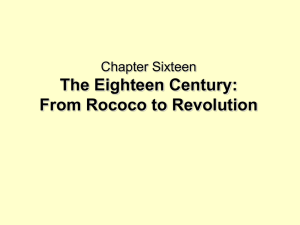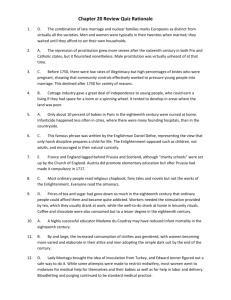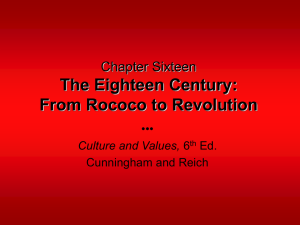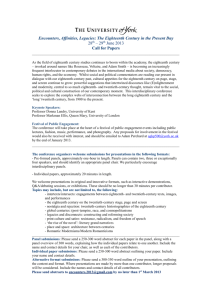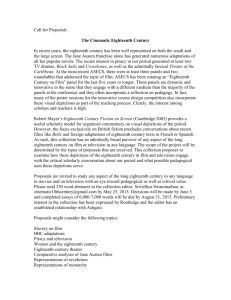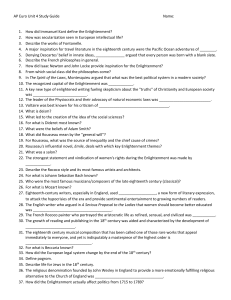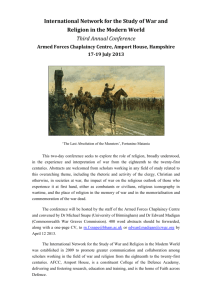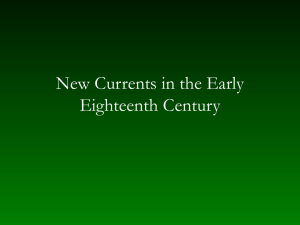chapter16.2014 - WordPress.com
advertisement
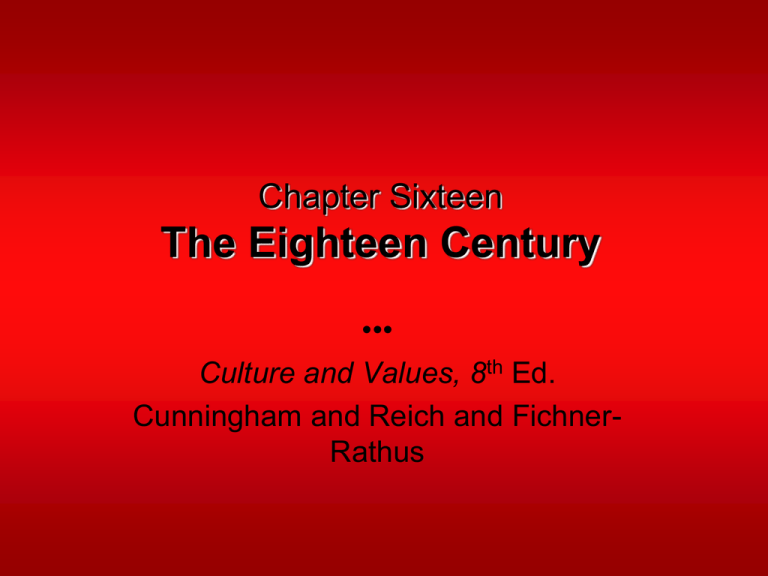
Chapter Sixteen The Eighteen Century ••• Culture and Values, 8th Ed. Cunningham and Reich and FichnerRathus Age of Diversity Unqualified optimism, extreme discontent Conscious engagement with social issues Revolutionaries and conservatives Enlightened despots Welfare of citizenry Duty and responsibility Rational Humanism Encyclopédie Denis Diderot (1713-1784) System for the classification of knowledge Compendium of human rationality Freedom of conscience and belief "If exclusive privileges were not granted, and if the financial system would not tend to concentrate wealth, there would be few great fortunes and no quick wealth. When the means of growing rich is divided between a greater number of citizens, wealth will also be more evenly distributed; extreme poverty and extreme wealth would be also rare." -- Diderot Literature in the Eighteenth Century Intellectual Developments Systematic examination of society Pessimistic views vs. Optimistic views Renewed interest in Classical culture Translations, themes, forms, references English Augustan movement Imitated Roman Augustan poets Return to order after English Civil War Literature in the Eighteenth Century Rational Humanism: The Encyclopedists Charles-Louis Montesquieu (1689-1755) Distribution of governmental power Jean-Jacques Rousseau (1712-1778) Humans=good, society=bad The “noble savage” Contempt for superficial, artificial Belief in human equality Rococo Style in Europe Elegant designs and pastel color base Frivolous, playful subjects Curves and dainty figures Favored by aristocratic class which were more concerned with pursuit of pleasure Mainly developed in France in wake of death of Louis XIV SLIDE: Germain Boffrand’s Salon de La Princesse, Hotel de Soubise, Paris. Begun 1732 This room is the setting for an ensemble of canvases by Fragonard and a remarkable group of French eighteenth-century furniture. Four of these canvases — The Pursuit, The Meeting, The Lover Crowned, and Love Letters — were commissioned in 1771 for Madame du Barry, mistress of Louis XV, and were installed in a new pavilion on the grounds of her château at Louveciennes. Upon their completion they were rejected in favor of a series commissioned from Joseph-Marie Vien. The Visual Arts in the Eighteenth Century The Rococo Style Escapism, antibaroque Frivolity, lightheartedness Art as entertainment for aristocracy Jean Antoine Watteau (1684-1721) Fetes galantes Return from Cythera (1717) 16.3 Jean Antoine Watteau, Return from Cythera, 1717 The Visual Arts in the Eighteenth Century The Rococo Style Jean Honore Fragonard 18th century life at its finest The Swing (1767) Rosalba Carriera (1675-1757 Pastel portraits Louis XV as a Boy (1720) 16.4 Jean Honore Fragonard, The Swing, 1767 16.5 Rosalba Carriera, Louis XV as a Boy, 1720 The Visual Arts in the Eighteenth Century The Rococo Style Giovanni Batista Tiepolo (1696-1770) Worked on a grand scale Allegory of Merit Accompanied by Nobility and Virtue (1757-58) Elisabeth Vigee-Lebrun Court painter to Marie Antoinette Marie Antoinette and Her Children (1781) 16.7 Elisabeth Vigée-Lebrun, Marie Antoinette and Her Children, 1781 The Visual Arts in the Eighteenth Century The Rococo Style England and America Portraiture and English Nobility Thomas Gainsborough Joshua Reynolds (1723-1792) • Austere poses, orderly decoration William Hogarth • Satirical “moral subjects” John Singleton Copley 16.8 Thomas Gainsborough, Mary, Countess Howe, ca. 1765 16.9 Sir Joshua Reynolds, Lord Heathfield, 1787 William Hogarth, The Marriage Contract, from “Marriage a la Mode.” 1743-45 16.11 William Hogarth, Breakfast Scene from Marriage à al Mode, ca. 1745 16.10 John Singleton Copley, Portrait of Paul Revere, 1768 The Visual Arts in the Eighteenth Century The Rococo Style Rococo sculpture Rococo architecture Balthazar Neumann (1687-1753) 16.12 Balthasar Neumann, Vierzehnheiligen pilgrim church, 17431772 The Visual Arts in the Eighteenth Century Neo-Classical Painting and Sculpture Archeological inspiration New awareness of classical art Roman Republic, French Revolution Jacques-Louis David (1748-1825) United opposition to tyranny Angelica Kauffmann Antonio Canova 16.14 Jacques-Louis David, Oath of the Horatii,1784-1785 16.15 JacquesLouis David, Napoleon Crossing the Alps, 1800 J. L David, The Death of Marat 1793 16.18 Antonio Canova, Pauline Bonaparte Borghese as Venus Victorious, 1808 The Visual Arts in the Eighteenth Century Neo-Classical Architecture Pantheon Inigo Jones Sir Christopher Wren Saint Paul’s Cathedral 16.20 Inigo Jones, Banqueting House at Whitehall, 1619-1622 16.21 Sir Christopher Wren, Saint Paul’s Cathedral, 16751710 Richard Boyle (Lord Burlington) Chiswick House 1724-29 Classical Revival, England Palladio, Villa Rotunda, Vicenza. Begun 1560s Thomas Jefferson. In 1796, Jefferson began to build a great house for himself atop a small mountain near Charlottesville, Virginia (Monticello means "small mountain" in Italian). He continued to build and modify the house until his death in 1826. The house is an expression of the Age of Enlightenment, with such features as a built-in calendar and a greenhouse. The design is Neoclassical in style, employing elements from Greek and Roman architecture. Classical Music Style gallant Empfindsamkeit C.P.E. Bach (1714-8) General vs. Technical definitions New musical idiom Emotion, intellect, balance, order Classical Music: The Classical Symphony Orchestral standardization Symphonic movements 1. Sonata form, sonata allegro form Exposition, development, recapitulation 2. Slow, lyrical movement 3. Minuet 4. Spirited, cheerful conclusion Classical Music: Haydn and Mozart Franz Joseph Haydn “Father of the Symphony” Reverence of artist in society Wolfgang Amadeus Mozart Early musical prowess, virtuosity The Marriage of Figaro Social injustice, universality of human nature Symphonies No. 39, 40, and 41 Literature in the Eighteenth Century Alexander Pope (1688-1744) Augustan poet Nature of human experience Rococo satire Tinged with personal hostility Christian + Humanist teachings Revelation of human folly Reverence for order, reason Literature in the Eighteenth Century Jonathan Swift (1667-1745) Hatred for human race “Savage indignation” • Animals capable of reason Gulliver’s Travels • Satire of human behavior A Modest Proposal • “Man’s inhumanity to man” • Inevitability of human suffering Literature in the Eighteenth Century Robert Burns (1759-1796) Mary Wollenstonecraft (1759-1797) Literature in the Eighteenth Century Voltaire (1694-1778) A man engagé Importance of freedom of thought “Ecrasez l’infame” Fanaticism and persecution Natural religion, morality Candide (1759) Folly of unreasonable optimism Cruelty and stupidity of the human race The Late Eighteenth Century: Time of Revolution Technological improvements Increased literacy, circulation of ideas Governmental abuses Louis XV: “Après moi le déluge” The Reign of Terror Maximilien Robespierre (1758-1794) Essentiality of constitutional government The Late Eighteenth Century: Time of Revolution American Revolution Inspired revolution in France Jefferson’s Declaration of Independence Optimistic view Political and social freedom Equality and justice Universality of man and nature Chapter Sixteen: Discussion Questions Explain Jonathan Swift’s “savage indignation.” Why does he hold such contempt for the human race? What is meant by the statement, “[reason] aggravates man’s natural corruptions”? How is this similar to and/or different from Rousseau’s outlook on humanity? What philosophical view of humanity was generated by the Encyclopedists? Explain how a collection of knowledge lead to new insights into religion, humanity, society, and government. In what ways does the rococo style support both the optimistic AND the pessimistic worldviews of the eighteenth century? Consider the influx of satire and the comparative frivolity of the art in addition to the changing role of the artist during the period.
